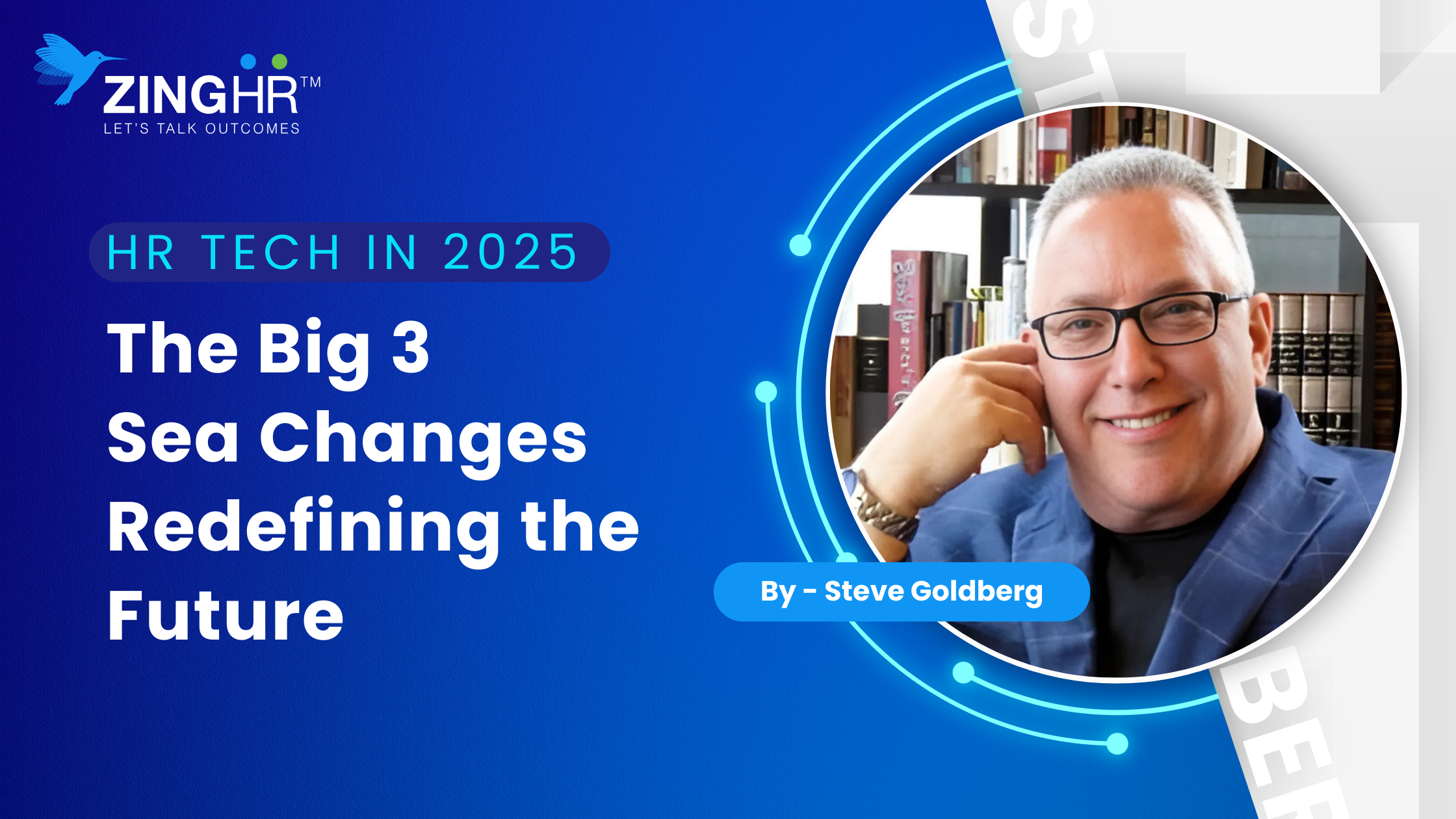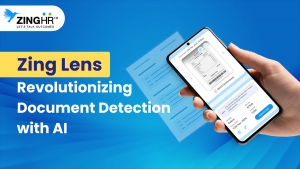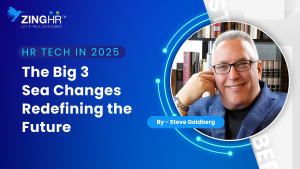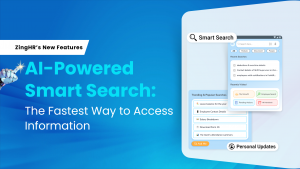A true inflexion point, finally!
The HCM solutions and services landscape, including all HRMS and HR technology solution categories and go-to-market models, is at a major if not unprecedented inflexion point. I’m basing this assertion on over three decades of operating in senior roles on all sides of HR, HCM and HR Technology, and across three continents.
This unique diversity of lenses, as some have referred to it (e.g., when introducing me at industry events) spans practitioner executive positions, product strategy leadership roles at multiple HCM vendors, and more recently, operating as a principal analyst and advisor that’s also been formally recognized as a top-tier industry influencer.
Frankly, I am thrilled to see this so-called inflexion point since I’ve been advocating for some very fundamental, though elusive changes to be reflected in vendor offerings and approaches for many years now.
The entire spectrum of HR processes … whether we’re talking about workforce planning, recruiting, onboarding, performance management, learning and development, total rewards, succession planning, offboarding/alumni management — or the traditional administrative centres of payroll, benefits administration and HR compliance … are not just being optimized through more intuitive and logical experiences for stakeholders that engage with these processes.
I’m also referring to a sea change that involves a rethinking of the word ‘optimization’ itself. Indeed, the entire industry is no longer just optimizing and automating HR / Payroll process workflows and being more efficient about data collection, auditing and reporting. It has extended the ‘optimization lens’ to apply to very strategic business outcomes, many of which are dependent on a vital HR function and a robust HCM systems infrastructure. After all, these are what truly enable an organization to leverage its workforce as a primary source of competitive advantage.
In that context, I’ll add that one HR technology solution provider I’ve become familiar with called ZingHR actually leads in their messaging with one word to signify this exciting new paradigm.
The creative and perhaps emotive word is outcomation; and as someone that’s traveled to and collaborated with solution providers across India and Southeast Asia and had the pleasure of conversations with HR execs in UAE / Middle East, I’m happy to report the business outcome orientation and those outcomes directly linked with upward-trending business results is now being universally adopted. This is today’s operating context. In simple terms, one can say that “what” and “why” have now fully and completely supplanted “how” in almost all C-suite discussions.
[Note: ZingHR has 1,100+ customers and a complete HCM solution suite replete with AI-powered conversational bots, facial and GPS recognition for more than just sign-ons, extensive visualization capabilities, a mobile-first design and even blockchain-assured data privacy.]
What’s so Different this Year? It Starts with ‘the Big 3’
When we talk about what’s so different this year in the world of HR Tech, and it’s someone with my professional context and origins that is expressing these perspectives, it starts with the “big 3.” Then there are several other relatively new dynamics, although one level down as I see it.
3 Dimensions that most Characterize the sea Change upon us in HR Technology
1. Let’s begin, as mentioned, with a clear emphasis on strategic, high-impact business outcomes, from both HR tech solution providers and customers. These “needle moving” outcomes include:
- Elevating organizational agility … as today’s highly fluid, often unpredictable operating environment results in the more frequent need to strategically, technologically or operationally pivot – including anticipating when, knowing how and executing well.
- Achieving “employer of choice” status … as it directly enables the hiring and retaining of top talent which drives major competitive advantage.
- Improving employee productivity … because very modest upticks at the enterprise level can easily translate into significantly better financial performance.
Moreover, this focus on using HR tech to achieve high-impact business outcomes has now rightfully replaced the long-standing obsession with the “means to get there.” I’m referring here to the proverbial exercise by many organizations of chasing the latest innovations, and we all know what they are.
I’d even go so far as to say the various shiny objects promoted by solution purveyors as new system features are now generally taking a back seat to the business outcome orientation of buyers, something I also describe as the “proof point posture.” After all, new features can now be tested and added in a matter of weeks or even days now.
In contrast, foundational “platform attributes” like scalability, usability, interoperability and configurability take a solution provider much longer to improve upon.
2. HR tech innovation is now widely seen as the path to strategic business outcomes (i.e., the “how”), not the outcomes themselves.
Naturally, this pertains to the ubiquitous, ever-expanding AI arena as the main innovation driver, but it’s actually the pairing of AI with talented, energized individuals in the workforce.
My former colleague Josh Bersin (we worked together at his firm back in 2010) refers to this powerful tag-team as the emergence of the super-worker and describes this new segment of the workforce as “ … an individual leveraging AI to dramatically enhance his/her productivity, performance and creativity.
Super-worker companies are correspondingly defined as an organization that embraces this transformation, building a culture of adaptability where people reinvent themselves.”
Bottom line: This year we are talking about innovating more strategically, being extremely mindful of business outcomes that will truly move the needle, the innovations most relevant to realizing them, and fully accounting for the various investments, risks and dependencies to tap into those innovations, e.g., change readiness.
I’ll also note that today’s seemingly year-round or continuous exercises to optimize HR processes, whether we’re speaking of workforce planning, recruiting, on-boarding, upskilling, performance management, total rewards or succession planning, are now also much more centered around tangible business outcomes than experiences for participants.
3. Terms and phrases widely used in HR tech circles (e.g., in vendor messaging and customer business cases as well as internal marketing of a newly deployed HR tech asset), terms such as personalized, immersive and even best practice are now met with much more rigor and scrutiny.
Indeed, the era of “absolutes” is now essentially over and replaced by the qualifying perspectives and approaches of “it’s all relative” and “what’s the context?”. These are today’s totally appropriate catch phrases that keep all of these jargony, always only marginally valuable conveniences honest.
For example, with respect to personalization within a corporate learning experience, let’s keep in mind this doesn’t only relates to content, but also to medium and pace, etc. In other words, it’s about how each person learns best.
And when we talk about an immersive onboarding experience, which is considered an excellent if not best practice, more people are also applying the immersive lens to aspects such as corporate culture, team dynamics and the extent to which employee goals and interests for their onboarding experience are considered just as important.
And regarding some universal sense of best practice in HR and HCM, that’s also being rightfully tossed aside by the thinking of many organizations who view best practice simply as the practice that works best – in their operating context.
Three other key elements making 2025 fairly different in HR Tech Circles
The three additional topics or themes below are what almost always come up in my discussions with HR and HR tech professionals and senior executives as being squarely on their radar:
1. Skills and AI-powered Skills Science Takes Centre Stage
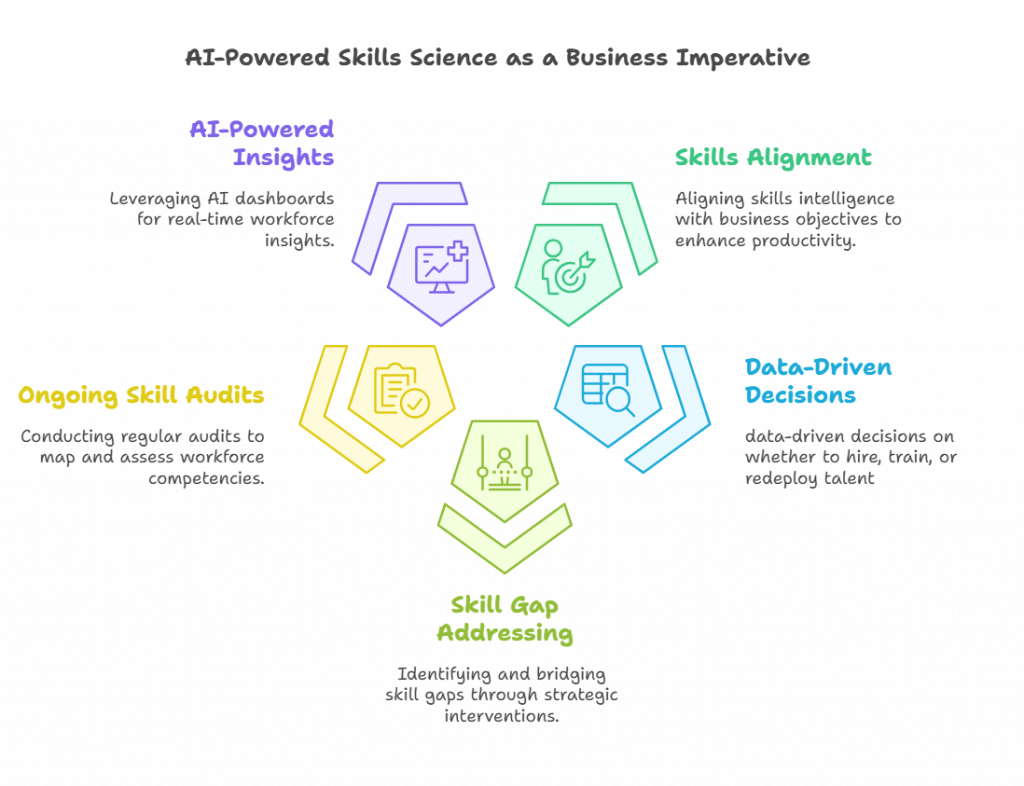
The topic of skills — and specifically, AI-powered skills insights and corresponding prescriptive actions — is quite hot and will likely get even hotter in 2025. As examples, knowing the most relevant skills (including soft skills) needed for each job IN THE CONTEXT OF CURRENT BUSINESS PLANS AND PRIORITIES is a “business execution imperative.”
Similarly, knowing the best options for addressing or mitigating skill gaps at both the individual and enterprise level can now also begin to reflect the holistic consideration of the 5 typical options: Hire regular employee, procure a contractor, upskill incumbent, redeploy another with adjacent skills, or outsource.
Finally, insights into skills equivalencies vs. adjacencies can now (or in the very near term) be looked at through the lens of ramp-up time to be considered a viable resourcing option. And obviously, skills insights or AI-powered skills intelligence is one of the many key workstreams that comprise a successful HR transformational initiative; and I’ll add that what is defined as a business transformation more broadly is getting closer to bow an HR transformation if=s framed in terms of both goals and blueprint.
2. A Best-in-Class Employee Experience (EX) can Now be Even Better!
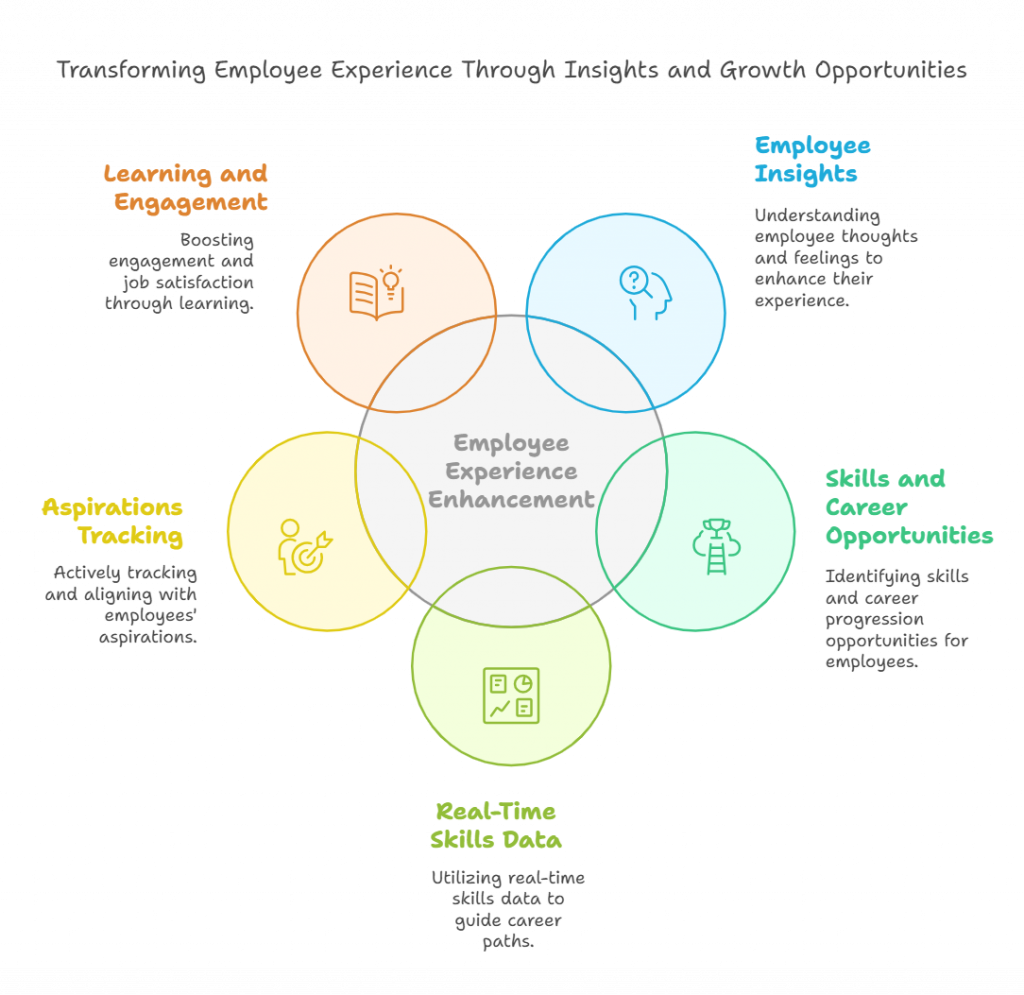
Recognizing that there was still considerable room for more forward-thinking views of the Employee Experience or ‘EX’, ones that facilitated the injection of empathy into what employees are thinking about, doing and feeling in their daily work lives (which of course is very changeable) has led, particularly when paired with AI and skills science, to a major breakthrough in HCM and HR tech my opinion.
I am referring to staving off key employee turnover by allowing them to “see what’s out there” that excites them even more at a certain juncture of their career journey of professional growth life cycle. This common scenario occurring every day for some of every organization’s workforce is where I’ll again highlight AI-powered insights into skills adjacencies and skills equivalencies but not stop there.
The other piece to this employee engagement and productivity puzzle is making sure people managers are leveraging HCM systems to (a) be aware of each employee’s career needs especially when there’s perceived stagnation, and (b) have tech guidance in regard to skill transferability and ideally, also, ramp-up times.
Additionally, valuing employees starts with understanding the myriad sources of value they deliver to the organization, many of which can be outside the confines of their role.
Examples include referring great job candidates, suggesting operational improvements, funneling sales leads, mentoring early career colleagues or performing a function that’s critical but often not officially recognized – that of a change agent or organizational connector.
These capabilities, when combined, can result in career development and growth modules within HCM platforms including the ability to “explore”, filtered based on the inputs outlined.
3. Predictive and Prescriptive Analytics in the Flow of Work … now a Reality
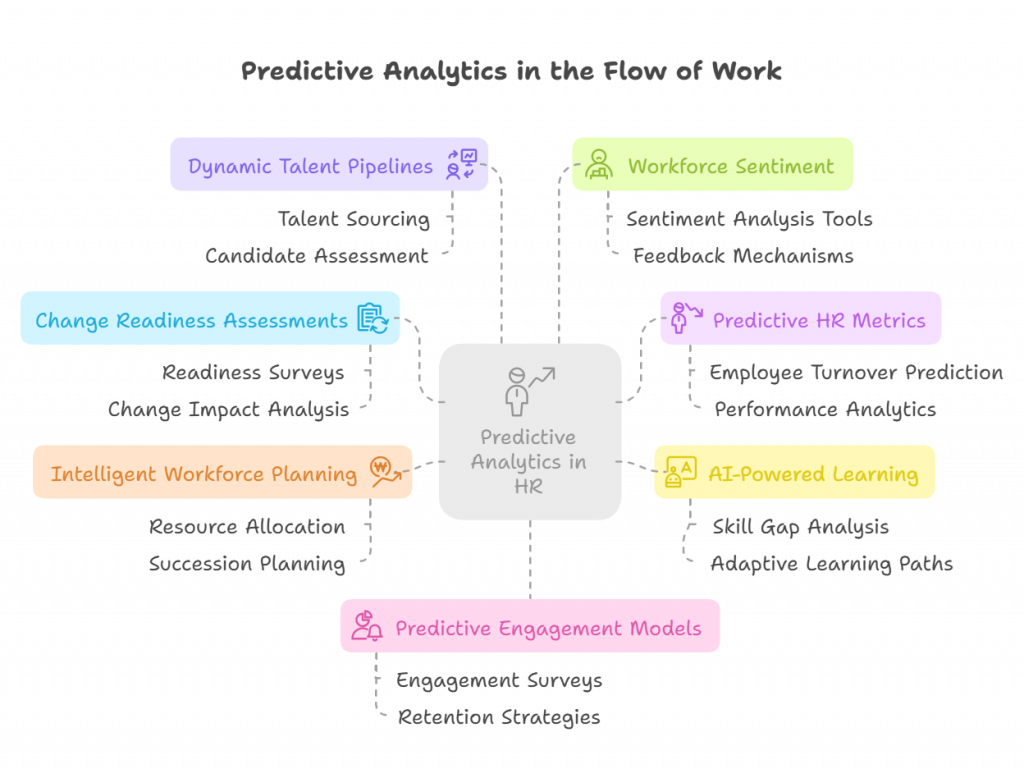
In several recent talks I’ve given on my favorite topic— elevating organizational agility, I’ve used a phrase I believe captures much of HR Tech’s role in what is likely today’s #1 business imperative.
The phrase is: “Make the invisible, visible.” So, below are just three of many HR tech capabilities or use cases behind the phrase; and I will also point out that, by virtue of the fact that whenever I publish pieces on this topic -– and the HR tech lens with which it can now be examined, the extreme level of interest displayed THIS YEAR underscores this as one of the hallmarks of what makes 2025 different in the domain we might all love: HR Technology.
- Visibility into “latent” or invisible skills or competencies (includes personal attributes), because they’re not on display in one’s current role. There are now many ways with AI / ML of inferring the presence of skills. Once ascertainer, this intel can lead to distinct competitive advantage about what major initiatives can be executed well, whether these be a transformational program, M&A, major restructuring, launching a new business, etc.
- Related to the above, many would agree with me that one of the most critical activities for HR leaders is to be able to reliably assess (including, predict) change readiness. This is of course a multidimensional endeavour with components related to employee attitudes, skills gaps and ideal mitigation steps, resourcing levels, potential environmental distractions, other known execution risks such as corporate culture (e.g., degree of transparency and trust), effective leadership and communications around the “why” behind the change. These are also fantastic opportunities for HR tech to make a major leap forward as a change enabler; and it’s certainly not a binary matter of certain functionality being present or not. This is arguably more about the mindset of the HR technology partner that hopefully manifests as a willingness to very tangibly work with and help their customers meet these very pivotal, company-defining moments. Any HR tech provider that can ability to switch gears and operate in a services mode deserves serious consideration in the vendor selection process.
- Finally, organizations now offer guidance through rapid yet highly effective learning experiences, personalizing them based on pace and preferred learning methods. Whether through web-based content, virtual reality, augmented reality, coaching, or workshops, individuals can engage with the material in the way that suits them best.
Concluding Remark
I personally thank ZingHR for giving me the opportunity to explore in this blog why I am convinced that 2025 will be a remarkable year for HR tech suppliers, customers, enthusiasts, and even occasional users within organizations. Based on the insights shared here, those who were once passive users may soon become enthusiastic adopters.

Steve Goldberg has been operating on all sides of HR, Payroll, HCM and HR Technology for over three decades and on three continents. After 15 years as a practitioner exec in Fortune 500’s, Steve led HCM product strategy at PeopleSoft as well as research practices at Bersin and Ventana Research. He also co-founded Recruiting Tech and Change Management firms. Steve has been recognized as a Top 100 HR Tech Influencer multiple times, earned an MBA in HR and a BBA in Industrial Psychology, and delivers talks at industry and solution vendor events around the globe. He currently serves as a strategic advisor to ZingHR.

